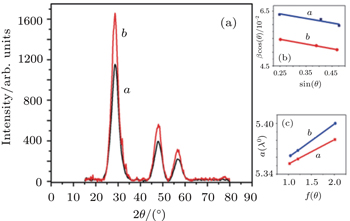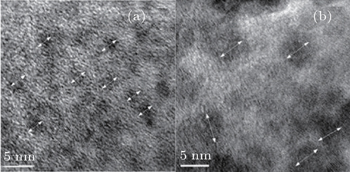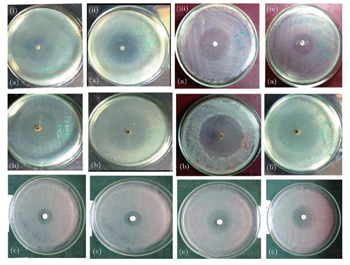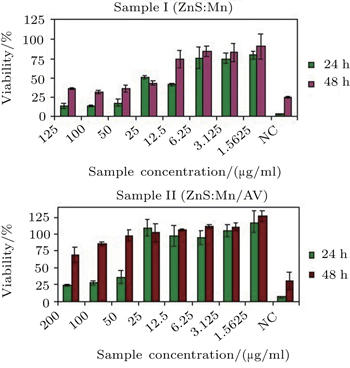† Corresponding author. E-mail:
Project supported by the Science and Engineering Research Board (SERB), Department of Science and Technology (DST), Government of India.
Toxicity of nanoparticles remains to be a major issue in their application to the biomedical field. Aloe vera (AV) is one of the most widely exploited medicinal plants that have a multitude of amazing properties in the field of medicine. Methanol extract of Aloe vera can be used as a novel stabilising agent for quantum dots to reduce toxicity. We report the synthesis, structural characterization, antibacterial activity and cytotoxicity studies of ZnS:Mn quantum dots synthesized by the colloidal precipitation method, using methanol extract of Aloe vera (AVME) as the capping agent. The ZnS:Mn quantum dots capped with AVME exhibit superior performances in biocompatibility and antibacterial activity compared with ZnS:Mn quantum dots without encapsulation.
In recent years, semiconductor nanocrystals have attracted widespread attention due to their unique properties and potential applications arising from quantum confinement effects.[1] The electronic structure of the nanoparticles will be modified when the crystallite size is comparable to their Bohr excitonic radius. Quantum dots exhibiting unique size dependent properties such as wide band gap and emission with tunable colours have shown their potential applications in displays, sensors, lasers, etc.[2–4] Mn is one of the most extensively used activators in ZnS because of its enhanced luminescence emission, lower toxicity and enhanced thermal and environmental stability. Recently, many techniques have been recognized to cap the surfaces of nanoparticles with organic substances or polymers to arrest the growth of nanoparticles and hence stabilize them from agglomeration.[5] Small bifunctional groups like thioglycolic acid (TGA), 3-mercaptopropionic acid (3MPA), or thioglycerol (TC) are generally used to passivate the surface of nanoparticles. Repeated and indiscriminate use of various antibiotics has resulted in the emergence of multi drug resistant pathogenic bacteria and other microbes. Hence there is an urge to develop novel compounds, preferably from natural sources, for effective treatment against infections. In the pursuit of developing such antimicrobial drugs, nanoparticles have been used in recent years due to their effectiveness compared with the bulk compound. Magnesium oxide, calcium oxide and zinc oxide nanoparticles have been employed as effective antimicrobial compounds against various gram positive and gram negative bacteria.[6,7] In the present work, methanol extract of Aloe vera (L) Burm.f (synonym Aloe barbadensis Miller) popularly known as Aloe vera is used as a capping agent to stabilize the doped nanoparticles, and it is aimed to study its structural properties and to evaluate the antibacterial activity of the AVME capped nanoparticles of ZnS:Mn(ZnS:Mn/AV) synthesized by the simple chemical precipitation method.
Thick succulent leaves of Aloe vera (AV) were cut into small pieces and dried at 40 °C in a hot air oven. The dried leaves were powdered using an electric blender and extracted in methanol using a soxhlet extractor for 48 h. The extract was vacuum evaporated and the dried powder was used for capping the ZnS:Mn nanoparticles. Quantum dots of ZnS–Mn and (ZnS:Mn/AV) were prepared by the colloidal precipitation method in a methanol medium.[8] 25-ml each of 1-M zinc acetate and 0.01-M manganese chloride were mixed by dropwise addition and continuously stirring. 25 ml of 1-M sodium sulphide was added to this solution mixture in the same manner. The resulting solution was heated to 70 °C and stirred for 20 min, which resulted in the formation of ZnS:Mn colloid. The precipitate was separated by filtering and it was washed several times with methanol. This powder was then dried by keeping in a hot air oven at 70 °C for 15 h. ZnS:Mn/AV quantum dots were also synthesized in the same manner by using AVME as capping agent for which the solution was prepared by dissolving 2mg of AVME in 10-ml methanol.
The sizes and structures of the dried samples were characterized by x-ray diffraction (XRD) using a Bruker AXS D8 advance x-ray diffractometer with Cu Kα radiation of wavelength λ = 1.5406 Å in the scan range 2θ = 20°–80°. The transmission electron microscopy (TEM) images of the samples were recorded using a high resolution transmission electron microscope JEOL 3010. Antibacterial assay of the ZnS:Mn quantum dots encapsulated with AVME (ZnS:Mn/AV) was done by the well-diffusion method[9] against four pathogenic bacterial strains such as Staphylococcus aureus (MTCC 7443), Escherichia coli (MTCC168 7), Pseudomonas aeruginosa (MTCC 1688), and Klebsiella pneumoniae (MTCC4030). These bacteria were cultured in a sterile nutrient broth so as to obtain a thick inoculum and were lawn cultured in nutrient broth for antibacterial assay. A gel puncher was used to make 4 mm × 4 mm wells on the agar media, sufficiently separated from each other to avoid overlapping of inhibition zones. 0.1-mg each of AVME powder, ZnS:Mn nanoparticle and (ZnS:Mn/AV) were poured into the wells and incubated at 37°C in a bacteriological incubator. Streptomycin was used as a positive control and methanol or nanoparticles alone as a reference control. The zone of inhibition was measured in terms of diameter in millimeters. Results were tabulated and subjected to statistical analysis using two-way analysis of variance (ANOVA) (SPSS Version 6.8, IBM, USA) and multiple comparison tests were conducted to verify whether the antibacterial activity of ZnS:Mn/AV was significant.
Alamar Blue assay was performed to test their cytotoxicities.[10] Different dilutions of samples were prepared in dimethyl sulfoxide ranging from 200 μg/ml to 1.625 μg/ml. Mesenchymal stem cells were seeded in a 96-well plate with a seeding density of 104 cells/well in triplicates for each sample dilution. 0.4-μl sample dilutions were added to each well and supplemented with 200-μl complete medium. Triton-treated cells were used as negative control (NC). Alamar Blue assay was performed after 24 h and 48 h.
In order to get a more in-depth insight into the effect of the capping agent in the nanostructure of the synthesized quantum dots, x-ray diffraction (XRD) measurements of ZnS–Mn nanocrystallites with and without capping agent are performed. The XRD patterns of the studied samples (Fig.
The three strong diffraction peaks corresponding to (110), (220), and (311) planes indicate the well crystallized nanoparticles and stabilities of ZnS nanocrystallites after the incorporation with Mn2 +, as well as the capping agent. Based on Scherrer's formula

By the Williamson–Hall (WH) method (Fig.

Here, parameters K, λ, and β have the same meanings as those given in Eq. (


The sizes of ZnS:Mn/AV and ZnS:Mn nanoparticles are 2.3 nm and 4.5 nm respectively according to the HRTEM images depicted in Fig.
Among the different materials tested for their antibacterial properties, ZnS:Mn/AV produces more zones of inhibition than AVME, methanol, and ZnS:Mn (Fig.
The ZnS:Mn/AV nanoparticle is found to contain quinines, alkaloids, anthraquinones, phenols, coumarins, tannins. and steroids as shown by the phytochemical screening experiments conducted in our laboratory. The anti-microbial properties of the plant against both gram positive and gram negative bacteria have been demonstrated.[14]
| Table 1. Zones of inhibition (mean (mm) ± SD) of bacterial strains against different test conditions. . |
From the results obtained from the present study, it can be inferred that Staphylococcus aureus is highly sensitive to Aloe vera leaf extract and is further clarified using ZnS:Mn/AV nanoparticles. These results support the use of Aloe vera leaf for the treatment of various kinds of gastrointestinal irritations. S. aureus is the normal microflora of skin, upper respiratory tract, and intestinal tract.[15] Further it has been reported that Staphylococcus aureus isolated from wound infections is susceptible to both Aloe vera gel and methanolic extract while Pseudomonas aeruginosa is susceptible to Aloe vera methanolic extract only.[16] The ZnS:Mn nanaoparticles capped with AVME show sensitivity against E.coli, Klebsiella pneumoniae, Stapylococcus aureus, and Pseudomonas aeruginosa, suggesting that Aloe vera coated nanoprticles of ZnS:Mn may be used in drug delivery for better interaction between microbes and the human body. Aloe–emodin (1,8dihydroxy-3-[hydroxymethyl]-anthraquinone is contained in Aloe vera leaf gel laxative, antifungal[17] antibacterial,[18] hepato-protective,[19] antiviral and antitumour activities.[20] A compound in Aloe arborescens Miller called aloctin A has antitumour activity, which was described by using methyl cholanthrene–induced murine-fibro sarcoma and lymphocytic leukaemia in syngeneic mouse system.[21]
Viabilities of mesenchymal stem cells, induced by ZnS:Mn and ZnS:Mn/AV nanoparticles, for different sample concentrations are analyzed by Alamar Blue assay and the percentage viability is calculated from the following relation

Percentage viabilities for different sample concentrations of ZnS:Mn and ZnS:Mn/AV nanoparticles are shown in Fig.
The present study demonstrates the use of methanol extract of Aloe vera as a capping agent in the synthesis of nanoparticles for biomedical applications. ZnS:Mn/AV shows the enhanced biocompatibility in conjunction with antibacterial activity, making it a potent candidate for medical research especially in the field of development of antibiotics and for cosmetic treatments. Future work will investigate further the luminescence property of ZnS:Mn/AV nanoparticles and its applications in the biomedical field like bioimaging and cancer detection.
| 1 | |
| 2 | |
| 3 | |
| 4 | |
| 5 | |
| 6 | |
| 7 | |
| 8 | |
| 9 | |
| 10 | |
| 11 | |
| 12 | |
| 13 | |
| 14 | |
| 15 | |
| 16 | |
| 17 | |
| 18 | |
| 19 | |
| 20 | |
| 21 |






